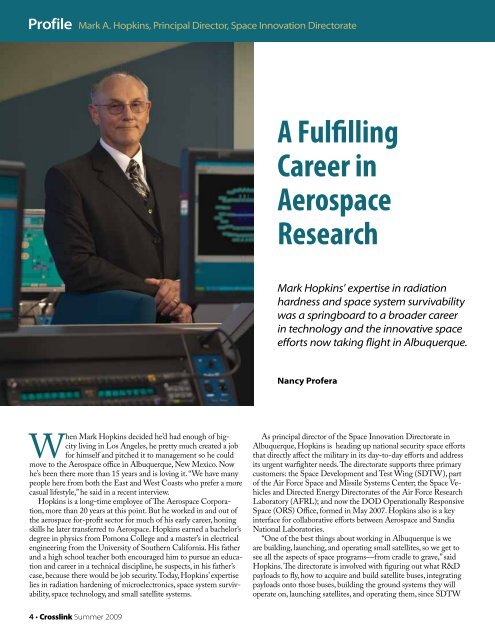Developing Responsive and Agile Space Systems - Space-Library
Developing Responsive and Agile Space Systems - Space-Library
Developing Responsive and Agile Space Systems - Space-Library
You also want an ePaper? Increase the reach of your titles
YUMPU automatically turns print PDFs into web optimized ePapers that Google loves.
Profile Mark A. Hopkins, Principal Director, <strong>Space</strong> Innovation Directorate<br />
A Fulfilling<br />
Career in<br />
Aerospace<br />
Research<br />
Mark Hopkins’ expertise in radiation<br />
hardness <strong>and</strong> space system survivability<br />
was a springboard to a broader career<br />
in technology <strong>and</strong> the innovative space<br />
efforts now taking flight in Albuquerque.<br />
Nancy Profera<br />
When Mark Hopkins decided he’d had enough of bigcity<br />
living in Los Angeles, he pretty much created a job<br />
for himself <strong>and</strong> pitched it to management so he could<br />
move to the Aerospace office in Albuquerque, New Mexico. Now<br />
he’s been there more than 15 years <strong>and</strong> is loving it. “We have many<br />
people here from both the East <strong>and</strong> West Coasts who prefer a more<br />
casual lifestyle,” he said in a recent interview.<br />
Hopkins is a long-time employee of The Aerospace Corporation,<br />
more than 20 years at this point. But he worked in <strong>and</strong> out of<br />
the aerospace for-profit sector for much of his early career, honing<br />
skills he later transferred to Aerospace. Hopkins earned a bachelor’s<br />
degree in physics from Pomona College <strong>and</strong> a master’s in electrical<br />
engineering from the University of Southern California. His father<br />
<strong>and</strong> a high school teacher both encouraged him to pursue an education<br />
<strong>and</strong> career in a technical discipline, he suspects, in his father’s<br />
case, because there would be job security. Today, Hopkins’ expertise<br />
lies in radiation hardening of microelectronics, space system survivability,<br />
space technology, <strong>and</strong> small satellite systems.<br />
As principal director of the <strong>Space</strong> Innovation Directorate in<br />
Albuquerque, Hopkins is heading up national security space efforts<br />
that directly affect the military in its day-to-day efforts <strong>and</strong> address<br />
its urgent warfighter needs. The directorate supports three primary<br />
customers: the <strong>Space</strong> Development <strong>and</strong> Test Wing (SDTW), part<br />
of the Air Force <strong>Space</strong> <strong>and</strong> Missile <strong>Systems</strong> Center; the <strong>Space</strong> Vehicles<br />
<strong>and</strong> Directed Energy Directorates of the Air Force Research<br />
Laboratory (AFRL); <strong>and</strong> now the DOD Operationally <strong>Responsive</strong><br />
<strong>Space</strong> (ORS) Office, formed in May 2007. Hopkins also is a key<br />
interface for collaborative efforts between Aerospace <strong>and</strong> S<strong>and</strong>ia<br />
National Laboratories.<br />
“One of the best things about working in Albuquerque is we<br />
are building, launching, <strong>and</strong> operating small satellites, so we get to<br />
see all the aspects of space programs—from cradle to grave,” said<br />
Hopkins. The directorate is involved with figuring out what R&D<br />
payloads to fly, how to acquire <strong>and</strong> build satellite buses, integrating<br />
payloads onto those buses, building the ground systems they will<br />
operate on, launching satellites, <strong>and</strong> operating them, since SDTW<br />
4 • Crosslink Summer 2009

















